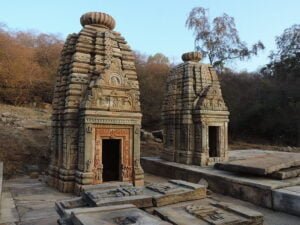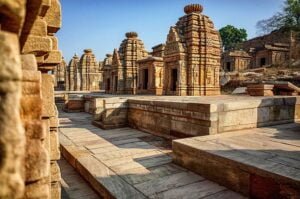No products in the cart.
GWALIOR- GATEWAY TO HIDDEN ARCHAEOLOGICAL JEWELS
Madhya Pradesh
Travels Amongst The Playing Fields Of The Chambal Dacoits
The stories of Madyha Pradesh’s Morena district as the playing fields of the Chambal dacoits and antiquities robbers are well entrenched in local folklore and travel journals. However, intrepid travellers unable to resist the lure of exploring these forbidden haunts, located close to tourism’s biggie ‘Gwalior’ have come away with some rare and thrilling experiences.
Bateshwar, Padavali, and Mitawali with their archaeological treasures are well within a day’s exploring distance from the historic city of Gwalior. The trick is to leave early so you can spend some quality time at each of these. And you have time in hand you can even make it a two-day affair. Mitawali, Padavali, and Bateshwar areas it is believed to comprise a golden triangle centered around the university which was located here over 1000 years ago.
Bateshswar

Follow the Tansen Road out of Gwalior city to Padavali village, in Morena District. The 30 km drive takes you through tranquil rural vistas till you reach the tiny village, which has been catapulted into the limelight for its archaeological significance. Padavali village, an ancient Gurjara-Prathihara settlement, must have once been a bustling hub as a pilgrim hot spot thanks to over 200 temples which came up between the 8th and 11th centuries in the post-Gupta era. A sudden calamity, man-made (Islamic religious ire) or natural (an earthquake) in the 13th century resulted in a complete devastation of the site.
Bateshwar with its 200 odd temples came to light by chance in its ancient setting in the densely forested area of the Chambal Gorge. It was Alexander Cunningham, a British army engineer, who later went on to become the ASI chief in the Raj era, who visited the site of the devastation in 1881-82 and was blown away by the vast collection of temples, big and small, spread over a sprawl of 25 acres to the southeast of the village of Paravali Padavali. At the time only the Bhuteshwar Temple and a few other temples were left standing in this devastated site. In 1920 the site of the ruined temples was declared a protected area under the auspices of the Archaeological Survey of India (ASI).
However, the site became a hideout for the dacoit Nirbhay Singh Gurjar and his cohorts. The dreaded bandit had a 30-year illustrious career of murder, robbery and kidnapping. Little wonder no one dared to enter the lair of this particular ‘lion of the Chambal’.
There’s a gripping tale of how the then ASI Bhopal region superintending Archaeologist chief, Karingamannu Kuzhiyil Muhammed, was chafing at the bit to find a way to access and start restoring the temple site. He took the help of Lachu Singha, a dacoit who had voluntarily surrendered, to meet with Nirbhay Singh, who kind of ran a parallel government in 40-odd villages in the area and no one could touch him, so dreaded was he. The man had a bounty of 2.5 lakhs over his head by Uttar Pradesh and Madhya Pradesh police. Guns and women and wine, local lore has it, were his big weakness!
KK Muhammed prevailed upon Nirbhay Singh to let them do the restoration work reminding him that this was the legacy of his (Nirbhay Singh’s) forefathers and should be preserved for future generations of his clan. Furthermore, he pointed out, that the presence of the dacoits at the site had been a deterrent to the antiquities robbers from emptying the site over the decades. A chord struck the hardened criminal who finally agreed to let the ASI go ahead with the restoration work; but he only let them do so when the dacoits were out on a hunt. This was in 2005.
With Nirabhay Singh’s help, the ASI workers were safely able to restore 60 of the temples. It was a mind-boggling task as the team started gathering together remnants from the jigsaw puzzle of the massive site of the temple ruins. Initially, they were only allowed to fix the gateway and the four or five temples in front. But when Nirbhay came to see the results, he is said to have been astonished by the progress, but walked away, as if in silent affirmation that they could continue their work under his protection. Nirbhay Singh was in later months killed in an encounter with the police in Etawah in Uttar Pradesh.
However, the site was to face a threat from another direction. This was from the sand mafia. KK Muhammed again had to seek help to let him carry on his work at the site.
The temple complex is built along the tenets prescribed by ancient Hindu texts, the 4th-century Manasara Shilpa Shastra and the 7th-century Mayamata Vastu Shastra. The first temple, dedicated to Lord Vishnu stands on a hilly slope on the northwest of the site. A line-up of smaller shrines in sandstone are dedicated to Shiva and Shakti lies ahead of it. The largest temple of Lord Shiva, locally known as “Bhuteshwara”, was originally a Vishnu temple.
What excites archaeologists in particular about this site is the architects of the time were experimenting with a variety of temple construction options and sometimes a fusion of different styles.
The Bateshwar temple site is a work-in-progress and visitors here can see how tough the job of the ASI is to restore it to its former glory. About 80 of the 200-odd temples have already been restored, a hugely admirable effort to say the least. A surreal air still hangs around the complex despite the everyday vibe of workers and visitors who are scattered across the site.
To get your bearings there are three areas you can explore: the Bateshwar Group: with the temples dedicated to Lord Shiva; the Vishnu Group: spend time ruminating over sculptures and serene shrines that have been restored; Hanuman Temple: Situated close to the entrance, it is said that the dacoits used to worship at the shrine before taking off for their nightly raids.
Mitawali

The ancient Chausath Yogini Temple situated atop a hill offers splendiferous views of the lush rural expanses of the village. You need to haul yourself up about 100 steps to explore this temple, whose circular structure housing 64 small chambers for the yoginis, is said to have inspired Sir Edwin Lutyens, the principal architect of the Raj-era, when constructing the old Parliament House in New Delhi. The temple is believed to have been commissioned by the Kachchhapaghata king Devapala Raja Devapala in the 11th century, as claimed by an inscription dating to 1323 CE discovered at the site. The temple, a circular structure with a radius of 170 feet features a central open-to-sky courtyard and a pavilion used for rituals and dance performances. It is one of the rare chausanth yogini temples in India. What is unique about their structure is they are open to sky or hypaethral, shrines. The images of the yoginis (female practitioners of Yoga) have now been replaced with Shiva lingas. It is now also known as the Ekattarso Mahadeva Temple. The temple site, which is quite well preserved, is a protected monument under the ASI.
Padavali

About 5km away from Mitawali lies Padavali village with its small fortress ascribed to the Jat rulers in the 19th century. Two stone lions have long been guarding the partial remains of the temple. The steep flight of steps ends in the stunningly carved Mukha Mandal of the 10th-century (?) temple raised to Lord Shiva, which once flourished in this tiny village.
If only the stones strewn around the complex could speak what a galaxy of storytelling they would unleash! Before the Kachhapaghata dynasty left its stamp on the site it was under the sway of the Pratiharas and Chandelas. When archaeologist Alexander Cunnigham visited in the late 1880s, he encountered an open pillared hall with its roof resting on 16 pillars. Even at that time, there was no sign of the inner sanctum which appeared to have gotten lost in the mists of the past.
Don’t be disappointed. Be prepared to be blown away by the fantastic sculptures that covers every inch of the pillars, walls, and ceilings in the Mukha Mandal complex.
ACCOMMODATION Both Gwalior and Morena offer a range of stay options ranging from budget-friendly guesthouses to comfortable hotels.
ACCESS
Air: Rajmata Vijaya Raje Scindia Air Terminal or Gwalior Airport offers connectivity with Delhi, Mumbai, Indore, and Bhopal.
Rail: Gwalior Junction offers connectivity to major cities across India by direct train links.
Road: You can hire a taxi for the day from Gwalior or Morena to explore all three sites. Prepare to head back by 3-4 pm as these places get a bit isolated.
















